So, there's a lot of content already on your site. But how do you know which pages are helpful and which are not? The answer is to measure your content marketing efforts using the right metrics.
But which metrics should you track for your posts? This article covers the top 12 metrics to help you optimise your content efforts and meet your goals.
Before we get into it, let us understand the basics of content marketing metrics in detail.
What are content marketing metrics?

Content marketing metrics should be treated like scorecards to show how well your content (blog posts, videos, or even social media posts) is performing. They help you understand if your audience likes your content, if they share it, and if it helps you get more customers. These data points enable content marketers to assess the success of their content and offer insights into what is effective and what isn’t. Without these, content marketing efforts would be aimless and inefficient.
They cover both quantitative and qualitative data points. These metrics help businesses understand the impact of their content marketing strategy on their target audience, website traffic, and ultimately, their bottom line.
By tracking content marketing metrics, businesses can make data-driven decisions to optimise their content strategy, improve their online presence, and increase their return on investment (ROI).
The bare minimum that you might want to track would be the standard four metrics in Search Console; clicks, impressions, click through rates and average position:
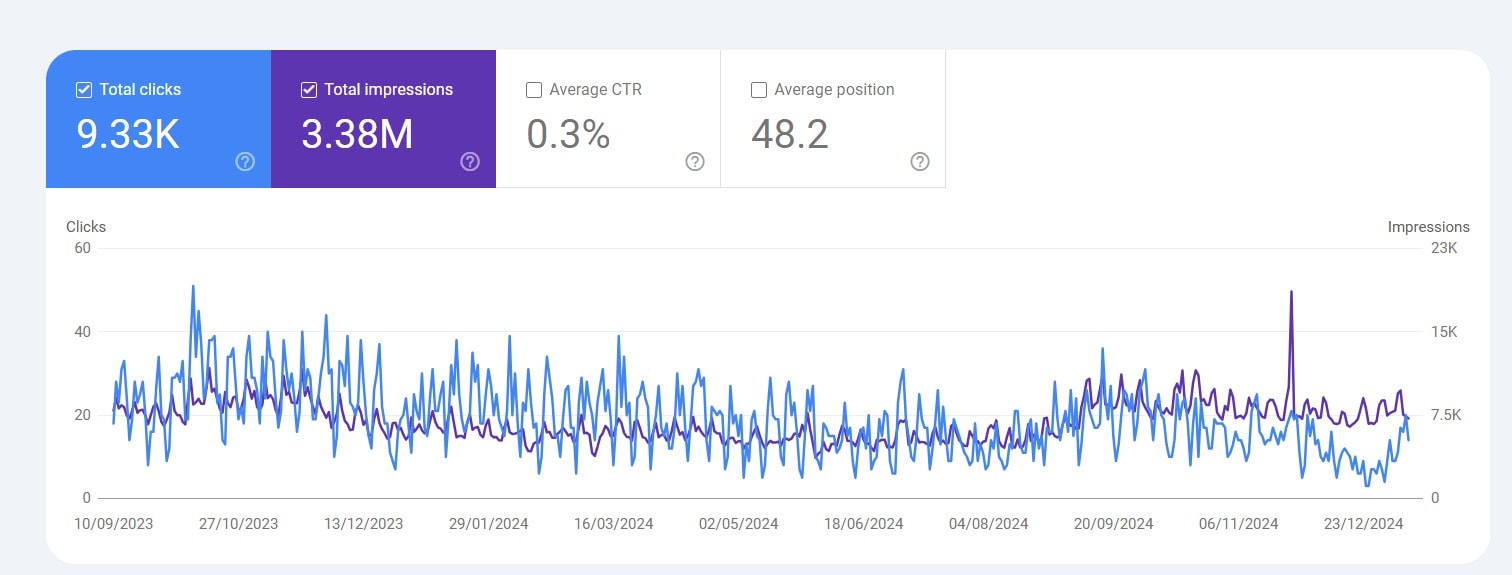
Why do you need to track content marketing metrics?
Each metric has a different meaning and value for different content purposes. Depending on your end goals, you can track these metrics, identify areas for improvement, adjust your content strategy, and, if needed, convey the goals to your content team.
Here are some of the many reasons why a business should be tracking them:
- Track the content’s impact on sales and revenue.
- Monitor how your content stacks up against competitors.
- Drive more visitors to your website.
- Set performance benchmarks.
- Find and fix underperforming content.
- Create a better experience for your site visitors.
- Improve your customer acquisition methods.
Setting content marketing goals and objectives
Before diving into metrics, ask yourself: What’s the real goal of your content marketing? Is it about producing engaging content that captivates your audience or driving leads into your sales pipeline? Maybe both. Is it about awareness of your brand or you as a person?
For instance, if your goal is lead generation, you could focus on tracking the average value of leads from your campaigns to see their real impact.
Do you want to nurture your sales pipeline? Measure how your content moves prospects from awareness to decision-making stages. Clear goals aren’t just guidelines—they’re the fuel that powers a data-driven strategy. Without them, even the best content risks becoming digital clutter.
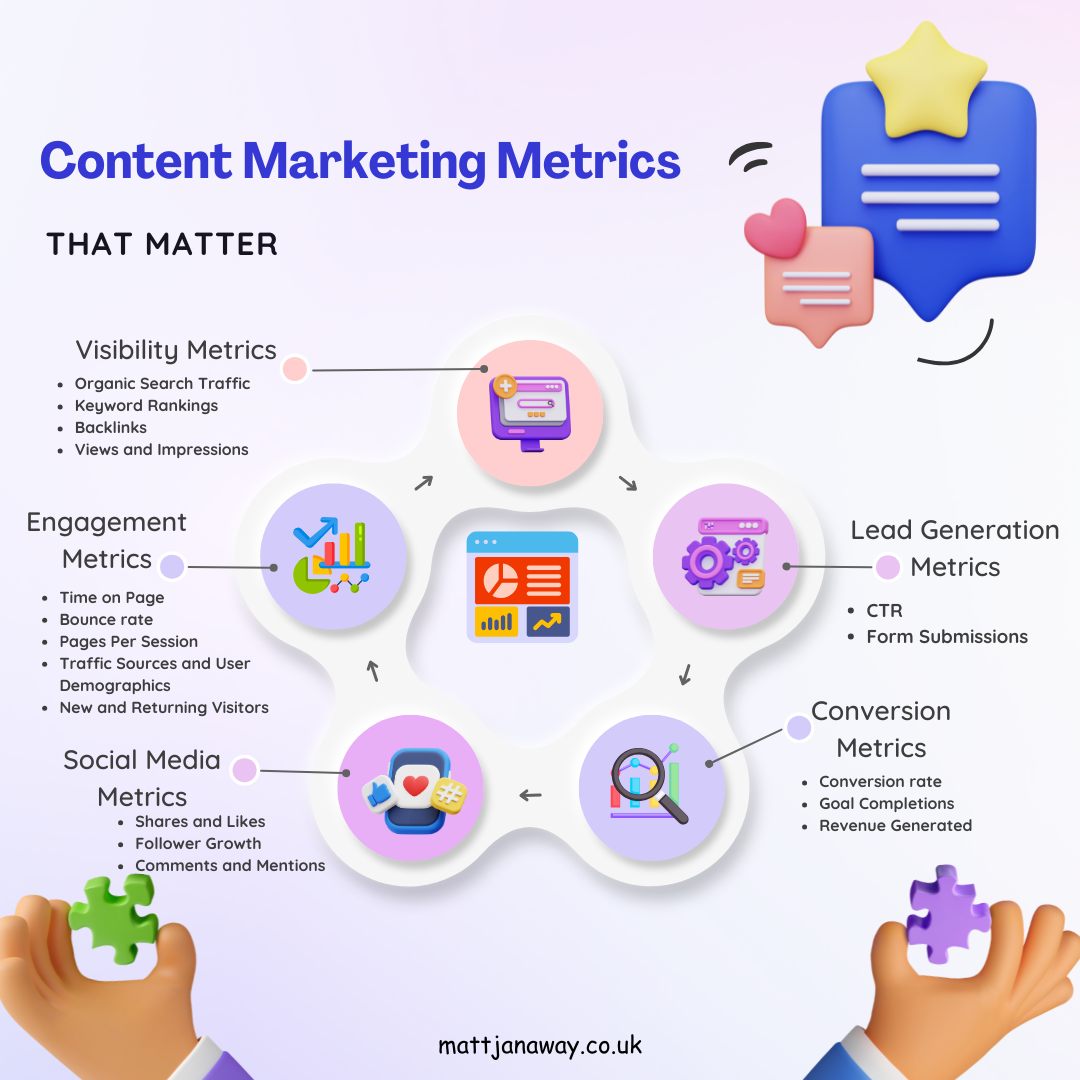
Metrics to track visibility
Visibility is the first step towards content marketing success. Metrics that measure how effectively your content is performing across search engines and social media are the most critical metrics.
Metric 1: Organic search traffic
Organic traffic refers to visits originating from unpaid search engine results, driven by natural search rankings. This helps you grasp the effectiveness of your website traffic and search engine optimisation (SEO) strategy. Tools like Google Search Console and Google Analytics are good for these purposes.
Higher organic traffic often correlates with better content visibility, relevance and yes, higher keyword rankings.
Metric 2: Keyword rankings
Anyone who understands content realises that keyword rankings are vital for SEO strategies. They determine content visibility for specific search queries. High rankings boost content discovery. Monitoring these rankings allows content marketers to optimise performance on search engine results pages.
Think about it this way: if your post doesn't show up when someone searches for it, does it even exist?
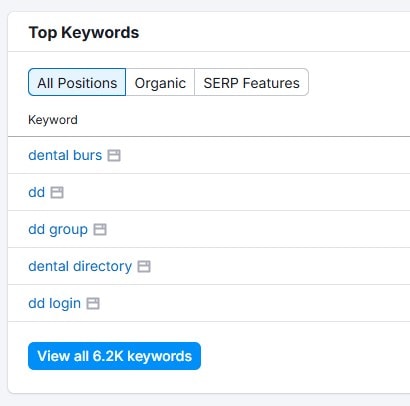
Metric 3: Backlinks
One of the strongest ranking factors is backlinks (links from other websites to yours). Often hard to acquire, these can improve search results and a site's credibility. They are like social handshakes, proving Google that your site is credible and dependable. High-quality backlinks from reputable sites can also improve a website’s link equity.

Metric 4: Views and impressions
How do you measure the reach and visibility of content? Views and impressions.
Views refer to the number of times a piece of content is viewed, while impressions refer to the number of times a piece of content is displayed or shown to users. These metrics can be tracked using Google Analytics, social media analytics tools, or other tools such as SEMRush or Ahrefs.
Monitoring these can tell a corporation how much traffic their content is generating, and how well their content marketing dashboard is performing. Is it reaching qualified leads, and is it reaching their target audience? For example, a high number of impressions but low views may indicate that while your content is being seen, it’s not motivating your users to take action.
Metrics to track engagement
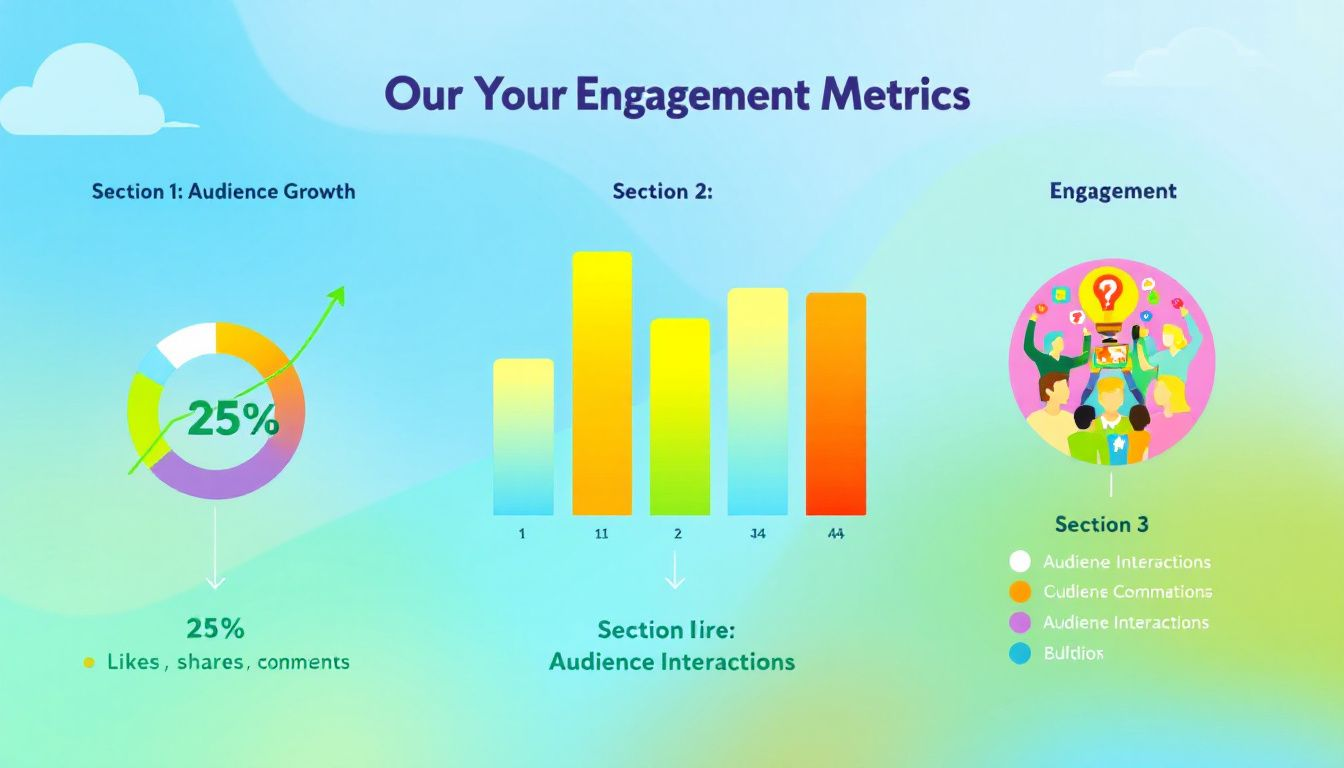
Engagement metrics assess how well your content captures and retains audience attention. Metrics like time on page and social shares of a blog post can point out how effectively a blog post retains audience attention and engages users.
Metric 5: Time on page
Time on page measures how long visitors remain on a particular page. It is a direct indicator of appeal factor of your content. Longer time spent usually means higher user engagement.
Significant time spent on your pages strongly suggests that your content resonates well with your viewers. You can use the free version of Microsoft Clarity dashboard to check these metrics.

Metric 6: Bounce rate
Bounce rate measures the percentage of visitors who leave after viewing just one page. A high bounce rate may suggest that your content fails to meet user expectations. A low bounce rate tells that users find your content useful and worth exploring further.
You can set it up with simple steps in your Google Analytics.
Metric 7: Pages per session
As it says in it's name, it is a measure of the number of pages a user views during a single visit. A higher number underlines effective content interlinking and user interest. It can tell you how effectively interlinked your content is. Are viewers able to navigate to the information they are looking for?
Remember, a higher number might also mean that users are struggling to find what they're looking for. So check this with the other key metrics such as bounce rate, average session duration etc.
Metric 8: Traffic sources and user demographics
Traffic sources and user demographics are two important content marketing metrics that help businesses understand where their website traffic is coming from and who their target audience is.
Traffic sources refer to the channels or sources that drive traffic to a website, such as organic search, social media, email, or paid advertising. User demographics refer to the characteristics of website visitors, such as age, gender, location, and interests.
By tracking traffic sources and user demographics, businesses can understand how to optimise their content marketing strategy to attract more traffic, engage their target audience, and drive conversions.
For instance, if a significant portion of your traffic comes from your social media channels, you might focus more on creating engaging social media posts to further boost traffic and engagement.
Find them under reports in the Google Analytics (GA4).
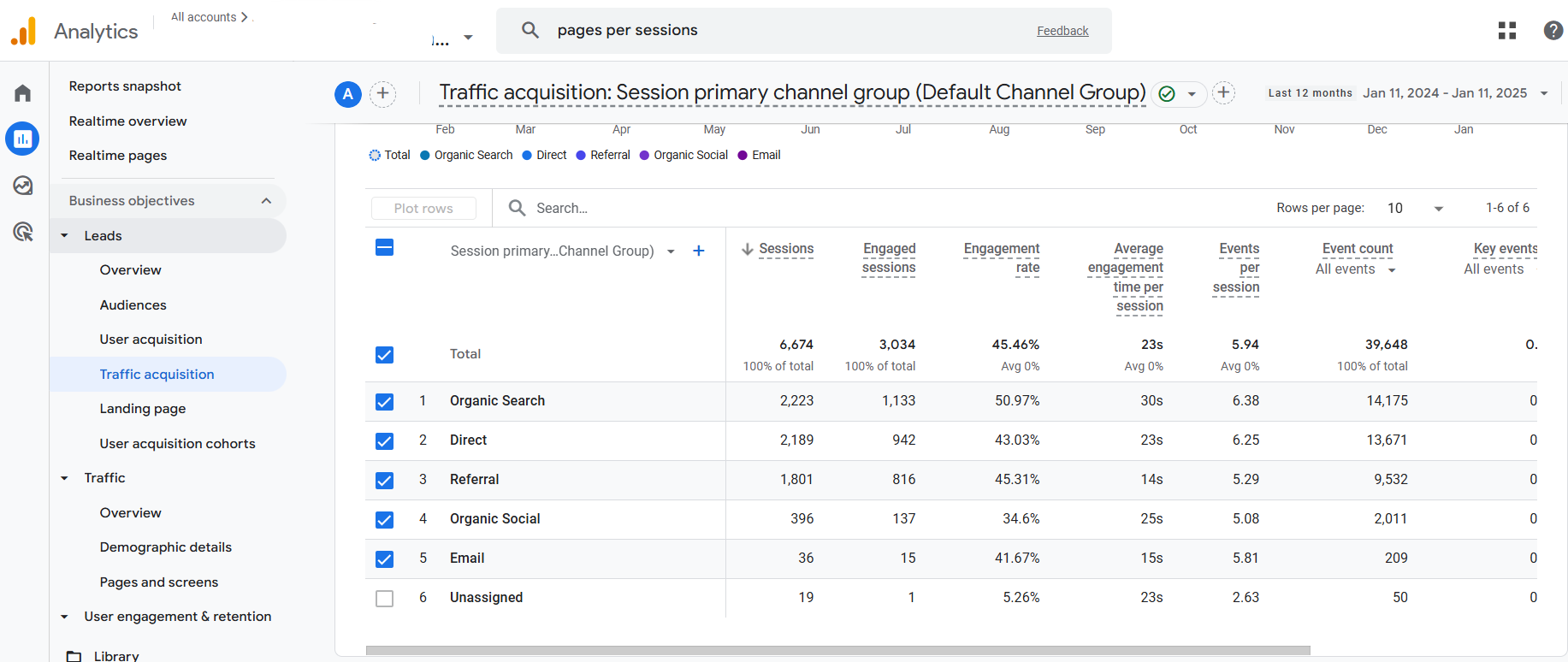
Metric 9: New and returning visitors
New visitors are those who land on your site for the first time, unique site visitors. Returning visitors are those who find enough value in your content to revisit.
Is your content marketing campaign working? Is it attracting new visitors, retaining existing visitors, or driving repeat business. For example, a high number of returning visitors means users find it worth their time, which is a positive sign of your content marketing campaign' success.
Lead generation metrics

Lead generation metrics determine how effectively your content marketing efforts generate potential customers. A well-optimised blog post can drive form submissions and demo requests with ease by encouraging readers to take action.
Metric 10: Click-through rates (CTR) of your CTA's
CTR measures the percentage of people who clicked on a link or call to action. It tells you if your content prompts engagement in your CTA's. A high CTR indicates strong messaging and relevance, while a low CTR may suggest the need to optimise titles or meta descriptions.
Metric 11: Form submissions
Form submissions measure how many visitors complete a form, be it contact forms, subscription forms, feedback forms, etc. High submission rates means that your content is able to invoke curiosity in potential customers. A higher number indicates a strong interest in your services.
Conversion Metrics
These metrics assess the direct impact of your content on sales and revenue. They reflect how effectively your content converts leads into customers, offering insights on content marketing ROI.
Metric 13: Conversion rates
The conversion rate metric measures how effectively your pages convert prospects into customers or leads. It is calculated by dividing the number of conversions by total visitors.
Strategies for improving conversion rates include creating a sense of urgency in your landing page. Adding testimonials, reviews, and user-generated content can influence potential customers. They show that others have had a good experiences with your product or service and thus lead to a higher conversion.

Metric 14: Goal completions
Specific actions taken by visitors, such as signing up for a newsletter or making a purchase are goals completion metrics. They indicate how well your content drives specific actions and meets business goals.
Complex goals can be broken down into simpler shorter steps (e.g., adding to cart, entering shipping information, completing purchase). Tracking each step tells tales of user behavior and where drop-offs occur.
Metric 15: Revenue Generated
When you make any type of investment, it's natural to assess the financial success of your content marketing efforts. For example, a blog generating $500/month in leads might be considered a high-performing asset.
Tools like Google Analytics allow for revenue tracking, providing up-to-the-minute insights. Use this metric to assess the overall profitability of your business and be in the know about high-performing products or services.
Social media metrics
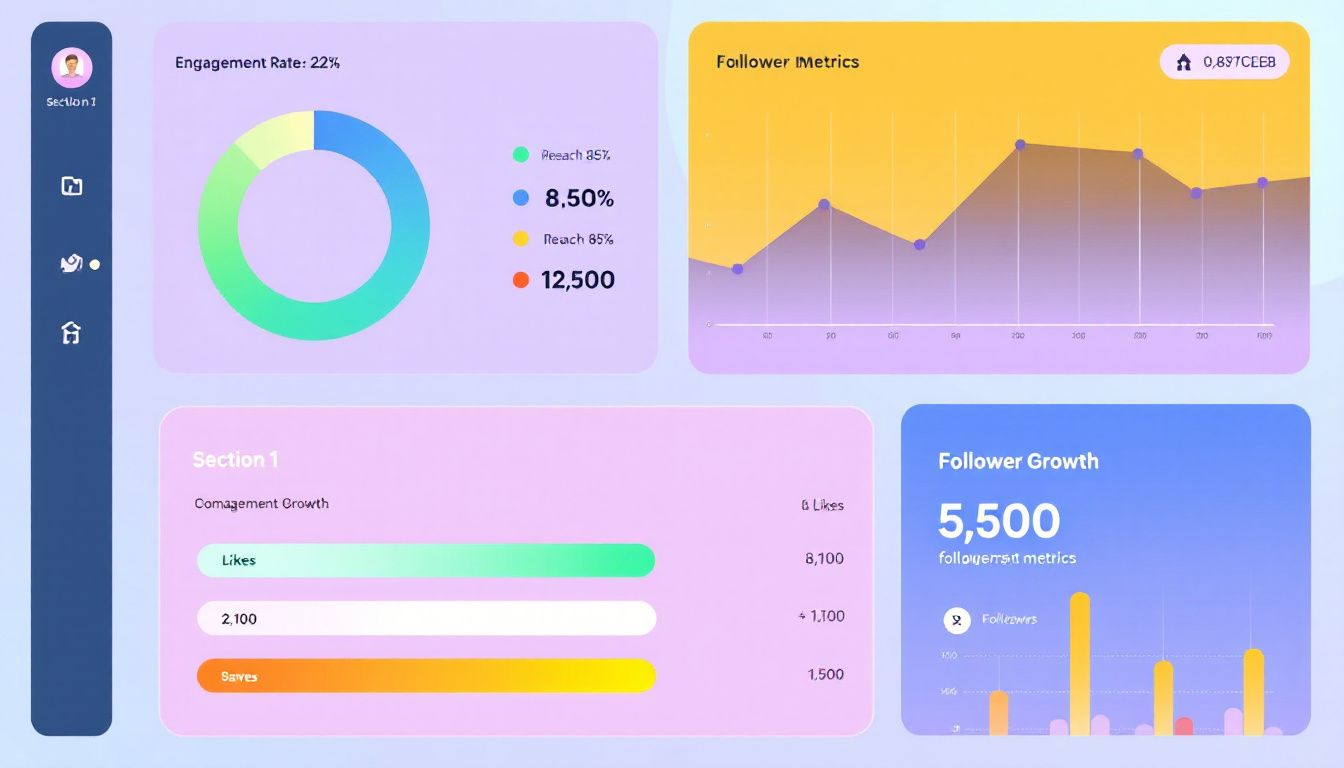
You can't ignore social media metrics when you are trying to stay ahead in the content game. When it comes to the performance of your posts across social media platforms, you need to be in the know. That is where these metrics come into play.
Metric 16: Shares and likes
Shares are directly proportional to the reach of your posts. It increases your audience reach, expands your network and also tells the viewer that their friend found your posts shareworthy. Number of likes talks about your content's approval metrics.
Metric 17: Follower growth
Follower growth measures how effectively your brand expands its audience. While numbers can be appealing, remember to choose quality of audience over quantity. Having engaged and targeted audience is always better than having a huge chunk of inactive followers. Its good to track these vanity metrics but do not get carried away by them.
Metric 18: Comments and Mentions
When a viewer comments on your post, they're giving up their time understanding your content and responding to it. This is direct feedback from your audience. Both positive and negative comments are good as they can help your marketing team identify areas of improvement and growth.
Advanced metrics and strategies
Customer journey metrics, attribution models, and A/B testing are also equally important. Tracking the customer journey from a blog post to product pages can provide insights into user behavior and engagement.
Metric 19: Customer journey
Customer journey metrics offer a treasure trove of insights, revealing how users transition from engaging with your pages. For content marketers and marketing leaders, tracking this helps to tap into user behavior, helping refine strategies for greater success. Measuring how many users read your blog and also visited your product pages can throw light into user behavior.
Metric 20: Attribution models
Attribution models are methods used to determine which marketing efforts or touchpoints (like ads, emails, social media posts) get credit for a conversion, such as a sale or sign-up.
For example, let's say you recently bought a pair of shoes online. Before buying, you might have seen an ad on Instagram, received an email, and searched for the brand on Google. An attribution model decides how much credit each of these interactions should get for your purchase.
Metric 21: A/B Testing
Comparing two versions of a webpage, email, or other marketing asset to determine which one performs better, is called as A/B testing. It is a powerful tool for optimisation. For instance, testing two CTAs can determine which drives higher conversions.
Tools for measuring content performance
Outdated and obsolete content can bring down your site statistics and you are better off without them. Thus, periodic analysis of performance metrics is necessary to identify areas needing improvement in your content strategy. Key tools include Google Analytics, SEMrush, and HubSpot.
There are a load of tools out there to assist you in this task. Here are a few:
Google Analytics
Google Analytics tracks various content performance metrics, making it essential for marketers. It provides key metrics such as page views, unique visitors, and average time on page to evaluate content effectiveness.
Semrush
Semrush excels in tracking SEO and keyword performance across web content. Features like position Tracking allow users to monitor keyword rankings across different locations and platforms.
HubSpot
HubSpot tracks lead generation metrics, including conversion rates and form submissions. The platform offers customisable dashboards to visualise key sales metrics, and performance.
Common mistakes in measuring content performance
- Not all metrics are equally valuable. Separate the standard metrics from the key performance indicators (KPIs).
- A study by Massifco found that 70% of marketers fail to set clear measurement priorities, resulting in inefficient use of resources.
- Don't ignore your user's feedback - be it verbal or written in form of comments or the silent ones - views, bounce rate, page per session, etc.
To wrap it up
As I mentioned earlier, not all content marketing metrics hold the same weightage. They differ for each content strategy. Take some time to learn about which metrics really useful for your specific content growth. Be it organic search traffic or keyword rankings tor tracking time on page and bounce rate, find out the content metrics that really matter. Tracking the right metrics of a piece of content can provide valuable insights into its key performance indicators.
The best content marketing isn't formed from a checklist but a path perfected over trial and errors. Start tracking your key metrics today and make informed decisions to drive your content marketing success.
Frequently Asked Questions
What’s the most important metric for measuring ROI?
The most important metric for measuring content marketing ROI is the conversion rate, as it showcases how effectively your efforts lead to sales. Focus on improving this metric to maximise your returns!
How can I improve my click-through rate (CTR)?
To boost your click-through rate, focus on crafting captivating headlines with powerful words and compelling meta descriptions. By making these changes, you'll attract more clicks and engage your audience effectively!
Why are engagement metrics important?
Engagement metrics are crucial as they indicate how well your content resonates with your audience, helping you improve its quality and appeal. By focusing on these metrics, you can enhance user experience and retention, driving greater success for your content!
How do I track organic search traffic?
To track organic search traffic effectively, utilise tools like Google Search Console and Google Analytics, which offer valuable insights into your content's performance from unpaid search results. Embrace these tools today to empower your online journey!
What are the benefits of updating old content?
Updating old content significantly boosts its relevance and can enhance your SEO rankings, ensuring it stays valuable for your audience. Take charge of your content strategy and watch your engagement grow!






